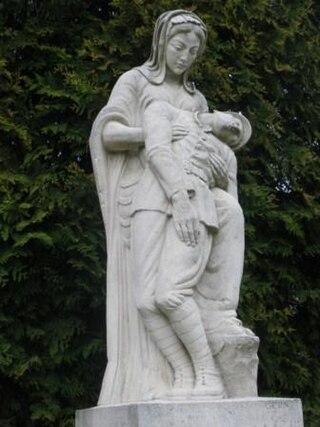
Vimy is a commune in the Pas-de-Calais department in the Hauts-de-France region of France. Located 3.8 kilometers (2.4 mi) east of Vimy is the Canadian National Vimy Memorial dedicated to the Battle of Vimy Ridge and the Canadian soldiers who were killed during the First World War. The Memorial is also the site of two Canadian cemeteries.

Walter Seymour Allward, was a Canadian monumental sculptor best known for the Canadian National Vimy Memorial. Featuring expressive classical figures within modern compositions, Allward's monuments evoke themes of memory, sacrifice, and redemption. He has been widely praised for his "original sense of spatial composition, his mastery of the classical form and his brilliant craftsmanship".

Givenchy-en-Gohelle is a commune in the Pas-de-Calais department in the Hauts-de-France region of France. It is located 1.8 kilometres (1.1 mi) north of the Canadian National Vimy Memorial dedicated to the Battle of Vimy Ridge and the missing First World War Canadian soldiers with no known grave; the Memorial is also the site of two Canadian cemeteries. The village was destroyed during World War I but was rebuilt after the war.

National Historic Sites of Canada are places that have been designated by the federal Minister of the Environment on the advice of the Historic Sites and Monuments Board of Canada (HSMBC), as being of national historic significance. Parks Canada, a federal agency, manages the National Historic Sites program. As of July 2021, there were 999 National Historic Sites, 172 of which are administered by Parks Canada; the remainder are administered or owned by other levels of government or private entities. The sites are located across all ten provinces and three territories, with two sites located in France.

The Canadian National Vimy Memorial is a war memorial site in France dedicated to the memory of Canadian Expeditionary Force members killed during the First World War. It also serves as the place of commemoration for Canadian soldiers of the First World War killed or presumed dead in France who have no known grave. The monument is the centrepiece of a 100-hectare (250-acre) preserved battlefield park that encompasses a portion of the ground over which the Canadian Corps made their assault during the initial Battle of Vimy Ridge offensive of the Battle of Arras.

Beaumont-Hamel is a commune in the Somme department in Hauts-de-France in northern France.

The Canadian Battlefield Memorials Restoration Project was a C$30-million Government of Canada capital project that aimed to restore and rehabilitate Canada's memorial sites in France and Belgium, in order to maintain and present them in a respectful and dignified manner.

The Beaumont-Hamel Newfoundland Memorial is a memorial site in France dedicated to the commemoration of Dominion of Newfoundland forces members who were killed during World War I. The 74-acre (300,000 m2) preserved battlefield park encompasses the grounds over which the Newfoundland Regiment made their unsuccessful attack on 1 July 1916 during the first day of the Battle of the Somme.
The 51st (Highland) Division Memorial at Beaumont-Hamel is a memorial in France commemorating the soldiers of the 51st (Highland) Division killed during World War I. The memorial is located near Y Ravine on the 84-acre (340,000 m2) Beaumont-Hamel Newfoundland Memorial site. This position had been the scene of the Division's first major victory on 13 November 1916 during the Battle of the Ancre, the closing stage of the Battle of the Somme.

Events of National Historic Significance are events that have been designated by Canada's Minister of Environment and Climate Change, on the advice of the national Historic Sites and Monuments Board, as being defining actions, episodes, movements or experiences in Canadian history. To be designated, an event must have occurred at least 40 years previous; events that continue into the more recent past are evaluated on the basis of what occurred at least 40 years ago. As of November 2022, there were 496 National Historic Events.
![]() Media related to National Historic Sites of Canada in France at Wikimedia Commons
Media related to National Historic Sites of Canada in France at Wikimedia Commons









